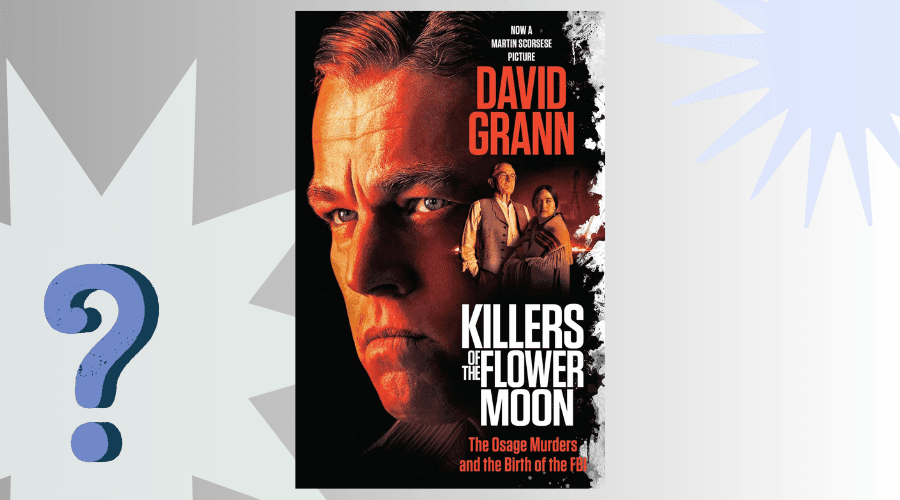Killers of the Flower Moon is the kind of book that belongs to a book club because it successfully melds true crime and history together in such an engaging way. It is a true story of the murders of the Osage in 1920s Oklahoma when members of the Osage Nation became phenomenally wealthy as oil was found on their lands. It is a story of greed, systemic racism, and corruption, all culminating in one staggering series of murders that helped shape the early FBI. Richly told, impeccably researched, this is true history, as well as a deeply moving experience.
This book offers so much for discussion. Its themes—systemic racism, greed, justice, and moral failure—are as relevant today as they were a century ago, creating opportunities for meaningful conversations about how history echoes in the present. The ethical dilemmas and institutional corruption revealed in the story also provide a platform for debating individual versus systemic accountability.
Another bonus? The recent Martin Scorsese movie adaptation gives your book club a fun way to extend the conversation. You could compare and contrast the book and movie, discussing how the story was adapted for the screen, what was emphasized or left out, and how each version presents the Osage Nation’s experience. Pair this book with a film discussion or even some light research on the Osage Nation’s history for a dynamic and insightful meeting. It’s a challenging read, but one that will definitely leave your group with plenty to talk about!
20 Killers of the Flower Moon Book Club Questions and Answers
Here’s a list of 20 book club questions for Killers of the Flower Moon with thoughtful answers to spark and guide your discussion. Feel free to tweak them based on your group’s interests!
- What were your first impressions of the Osage Nation and their wealth in the early 1920s? Answer: It’s fascinating how the Osage people turned their oil-rich land into incredible wealth. However, their prosperity contrasted starkly with the systemic racism and exploitation they faced, foreshadowing the tragedy.
- How does David Grann use storytelling to make the historical events feel immediate and engaging? Answer: Grann’s use of detailed, vivid scenes and a true-crime narrative structure makes the history accessible and gripping, almost like a thriller.
- What role does racism play in the events of the book? Answer: Racism is central—it underpinned how the Osage were dehumanized and exploited, allowing their murders to be dismissed or ignored by authorities.
- How did the Osage wealth challenge societal expectations at the time? Answer: The Osage defied stereotypes of Native Americans as impoverished and powerless, creating tension and resentment among white settlers.
- What stood out to you about Mollie Burkhart’s experience? Answer: Mollie’s story is heartbreaking—losing family members one by one while being caught in a web of betrayal by those she should have been able to trust.
- How do you view the FBI’s role in solving the case? Answer: While the FBI exposed the conspiracy, the book also highlights their limitations and motives, including Hoover’s desire to build the bureau’s reputation.
- Were you surprised by the scale and organization of the murders? Answer: The sheer number of people involved in the conspiracy, including trusted professionals, was shocking and disturbing.
- How does the book critique law enforcement and the justice system of the time? Answer: Grann shows how corruption and indifference allowed the murders to continue unchecked, emphasizing the systemic failures in protecting the Osage.
- What did you think of William Hale and his manipulation of those around him? Answer: Hale’s ability to project a trustworthy image while orchestrating such evil makes him a chilling figure, embodying the insidious nature of greed.
- How does the book handle the Osage perspective? Answer: While it highlights their resilience and voices, some readers may wish for even more focus on their culture and agency in the story.
- How does this story compare to other true crime narratives? Answer: Unlike many true crime stories, this one explores systemic issues and historical context, giving it more depth and relevance.
- What emotions did the book evoke as you read? Answer: It’s a mix of anger at the injustice, sorrow for the victims, and admiration for the resilience of the Osage Nation.
- How did you feel about the book’s ending and its reflection on justice? Answer: While some justice was served, the systemic exploitation of Native Americans persists, leaving the conclusion bittersweet.
- What role did the media play in the Osage murders? Answer: The media often sensationalized or ignored the murders, reflecting societal indifference to Native American suffering.
- How does this book resonate with issues of systemic racism today? Answer: It draws clear parallels to modern struggles with inequality, justice, and the marginalization of Indigenous communities.
- What impact did the discovery of oil have on the Osage Nation culturally and socially? Answer: While it brought wealth, it also attracted predators who sought to control or exploit the Osage, leading to profound cultural and social consequences.
- How does Grann explore the theme of betrayal? Answer: Betrayal is central, with family members and trusted individuals participating in the murders, which makes the crimes even more devastating.
- What do you think about the inclusion of David Grann’s own investigative journey? Answer: Grann’s personal involvement adds a modern perspective, connecting past and present while making the story feel more immediate.
- How does the book shed light on the broader history of Native American exploitation in the U.S.? Answer: The Osage murders are a microcosm of the larger pattern of exploitation, broken treaties, and systemic oppression faced by Native Americans.
- If you could ask the author one question, what would it be? Answer: Many might ask how he decided what parts of the Osage story to include and what he hopes readers will take away about justice and history.
These questions can spark deep and dynamic conversations, letting your group dive into the book’s themes, characters, and lasting impact.
Killers of the Flower Moon: Discussion Topics
Here’s an expanded version of the 5 discussion topics for Killers of the Flower Moon to give your book club even more depth:
Systemic Racism and Exploitation
The Osage murders were not just individual crimes but deeply rooted in systemic racism. Discuss how prejudice against Native Americans made the Osage Nation vulnerable to exploitation and violence.
- How did the legal system, such as the guardianship program, reflect and perpetuate this racism?
- In what ways did societal attitudes enable people to rationalize or ignore the suffering of the Osage?
- Are there parallels between the events in the book and the treatment of Indigenous communities today? How can these lessons inform current conversations about equity and justice?
The Role of Wealth and Power
The Osage Nation’s immense wealth from oil royalties challenged the societal hierarchy of the time, especially in predominantly white, rural Oklahoma.
- How did the Osage’s prosperity create tension between them and their non-Native neighbors?
- In what ways did greed motivate the conspirators, and how did the desire for power amplify the scale of their crimes?
- Discuss how wealth acted as both a blessing and a curse for the Osage. Could these tragedies have been avoided if their wealth had been managed differently?
Betrayal and Trust
Betrayal is a recurring theme, with people who should have protected the Osage—friends, family, and community members—turning against them.
- How did William Hale manipulate trust to orchestrate the murders?
- What does the betrayal by guardians, spouses, and community members reveal about human nature and the corrosive effects of greed?
- Consider Mollie Burkhart’s perspective: how might it have felt to realize that her closest relationships were built on deception and ulterior motives? How did this betrayal deepen the tragedy?
Justice and the Birth of the FBI
The FBI’s involvement in solving the Osage murders played a key role in establishing its reputation, but the book also raises questions about its limitations and motivations.
- How effective was the FBI in solving the murders and bringing the conspirators to justice?
- What were J. Edgar Hoover’s motivations in prioritizing this case, and how did he use it to shape the public image of the FBI?
- Do you think justice was truly served for the Osage Nation? What would justice look like in this context? Discuss how the crimes reflect broader failures of the justice system, and whether those failures have persisted.
Storytelling and Historical Truth
David Grann’s narrative approach combines historical research with the pacing and suspense of a true-crime thriller.
- How does his storytelling style make the events more accessible and engaging for modern readers?
- Do you think the book does justice to the Osage perspective, or do you feel more of their voices could have been included?
- Discuss how Grann’s inclusion of his own investigative process adds to the story. Does it help connect the past to the present, and what insights does it provide about how history is remembered and written?
- How does this book compare to other true-crime or historical narratives your group has read?
These expanded topics should provide your book club with plenty of material for an in-depth discussion about the book’s themes, characters, and broader implications. You can even pair these with additional research or a movie night featuring the Scorsese adaptation for a more interactive meeting!
How to make Your Killers of the Flower Moon Book Club more Interactive?
Here are 10 interactive ideas to make your Killers of the Flower Moon book club meeting more engaging and memorable:
Host a Movie & Book Comparison Night
Watch the Scorsese film adaptation and discuss how it compares to the book. What did the film emphasize or omit? How well were the characters, especially Mollie Burkhart and William Hale, portrayed? This adds a visual dimension to your discussion.
Create a Timeline of Events
As a group, map out the key events of the Osage murders and the FBI’s investigation. Use visuals like a whiteboard, sticky notes, or digital tools to see how the story unfolded. This helps everyone visualize the scope of the conspiracy.
Incorporate Osage Culture and History
Research and share information about the Osage Nation’s culture, history, and current initiatives. Play traditional Osage music or share images of their art. This adds depth to the discussion and honors the Osage people.
Dive Into True Crime
Share other true crime cases or books with similar themes. Discuss how Killers of the Flower Moon fits into the true crime genre and what makes it stand out.
Host a Trivia Game
Create trivia questions based on the book, covering the plot, characters, and historical context. Offer small prizes for correct answers to encourage friendly competition.
Discuss Over Themed Snacks
Prepare snacks inspired by the book’s setting, like Oklahoma-style barbecue or Indigenous recipes. Food always makes a meeting more fun and brings the story to life.
Explore FBI History
Research and present the history of the FBI, especially during J. Edgar Hoover’s early leadership. Discuss how this case shaped the bureau and whether the portrayal of the FBI in the book feels accurate or idealized.
Analyze Real-Life Parallels
Have a group discussion about current events or systemic injustices that mirror themes in the book. How do the lessons from the Osage murders apply to today’s struggles for justice and equality?
These interactive ideas will make your book club more dynamic, encourage participation, and provide a richer understanding of the book’s themes and historical context.

